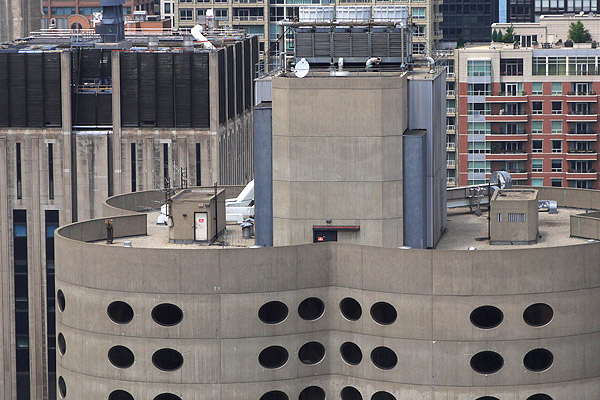
The protracted cold war over the fate of Prentice Hospital in Streeterville went on quietly for months this year, but all of a sudden it's back, and Ben Joravsky suggests its putting pressure on City Hall: "if Emanuel gives Northwestern its demolition permit—and let's face it, the permit doesn't get issued without the mayor's approval—he will be forever regarded by preservationists and architects (and maybe even his beloved New York Times) as the pinhead who destroyed one of Chicago's great buildings."
But "great" doesn't always mean beloved, and people tend to hate brutalism, and not just because of the unfortunate name: the dirty look of the concrete, the claustrophobically small windows, the associations with penal institutions and public housing. All along the fate of its preservation has rested with the ability of "cloutless" architecture preservationists to build up popular support for Prentice, of the kind that Michael Reese, located farther from the city center, never had behind it. And Prentice is a tough sell. In The Awl, Anthony Paletta has a nice essay on the brutalist form, and its ugly beauty, highlighted by the appearance of Prentice, in which he puts his finger on the ill associations of the form: "There’s no doubt that Brutalism remains associated with the very worst of top-town mass-planning tendencies in American cities, of the sort that bulldozed vibrant neighborhoods into arid plazas." So much of it was done so badly, in the service of such bad ideas, that it almost inevitably carries the aura of urban decay:
Here "Brutalism" fulfills the same role as "jam bands" as a shorthand category for sweeping disdain. It's be tempting to attribute the misfortunes of Brutalist architecture to semantics; after all, no other 20th-century form of architecture—the International style, Constructivism, Postmodernism—directly conjours images of violence and force…. There are, of course, accurate aesthetic objections—bare concrete, however improperly labeled, doesn’t inspire much popular enthusiasm. Look to any list of “ugliest buildings” or “buildings to demolish now” and you’re sure to find multiple Brutalist structures represented. The Trellick Tower in London was said to be the inspiration for J.G. Ballard’s novel High Rise, in which society breaks into conflict, chaos, and dog-eating amidst in a self-contained concrete tower mass. Ian Fleming titled a villain after that building’s architect, Erno Goldfinger. That doesn’t happen to Frank Gehry.
The preservationists have some legitmately good arguments for the preservation of a building not everyone likes—it's a technical wonder, and a landmark in building design, but you can't see math. So they have an interesting dilemma: can they convince a city that a building is beautiful?
They've got a lot more help these days. Eminent architecture critic Paul Goldberger took to Vanity Fair with a defense:
More significant still, it’s an exceptionally important building in the evolution of health-care design, incorporating new ideas about the connection between architecture and childbirth. The cloverleaf plan was intended to create “quiet villages” of patient rooms, encouraging family-oriented childbirth, one of the first times this idea was essential to a hospital’s design. Beyond making health-care history, Prentice made architectural technology history, too: it was designed using an early form of computer modeling, making it, in effect, a guinea pig for the digital systems by which almost everything is now designed.
Then again, even Goldberger can't help but say that it's "a little weird, yes, but the more you look at it, the more you like it."
So much of Prentice's genius is invisible: the balance of forces you can't see, the mothers and nurses that are no longer there. In 2009, Mason Curry detailed what was brilliant about it, and also how that got left behind by technical change:
Jean Mah, a principal of Perkins + Will who specializes in health-care design, is a little more sanguine about Goldberg’s designs. But she agrees that the cluster layout has proved inadequate to rapid expansions in room size, equipment, and technology. “Everything has gotten larger, including the patient,” Mah says. “If you were to take the same number of beds at today’s room size and try to arrange them in that four-leaf clover, it would be so much bigger that it wouldn’t work as a geometry, because you would need a much bigger site. It would just explode exponentially.”
Prentice was built as a tool; now the preservationists have to convince the city that it's an object of beauty.
Photograph: smaedli (CC by 2.0)


